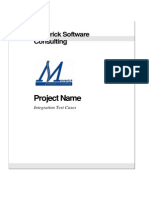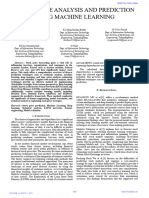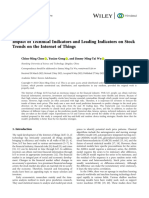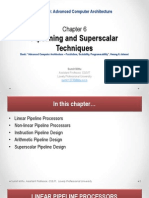Stock Prediction System Using ML
Stock Prediction System Using ML
Volume 9, Issue 12, December – 2024 International Journal of Innovative Science and Research Technology
ISSN No:-2456-2165
Stock Prediction
System Using ML
Akash Kumar1 Garima Panwar2
Amity School of Engineering and Amity School of Engineering and
Technology, Amity University, Technology, Amity University,
Uttar Pradesh, India Uttar Pradesh, India
Anant Samrat3
Amity School of Engineering and
Technology, Amity University,
Uttar Pradesh, India
Abstract:- The stock market is a complex and dynamic and auto regressive integrated moving average (ARIMA)
system characterized by significant volatility and models. While these methods provide a basis for forecasting,
uncertainty[1]. Accurate prediction of stock prices is they often fall short when it comes to capturing the dynamic
crucial for investors and financial analysts to make and non-linear characteristics of financial markets.
informed decisions and maximize returns. Traditional Traditional models struggle to account for the multifaceted
forecasting methods often fall short due to their reliance interactions and sudden shifts in market trends, which are
on historical data alone and their inability to adapt to crucial for accurate predictions.
rapid market changes. In recent years, machine learning
(ML) has emerged as a powerful tool for enhancing stock In recent years, machine learning (ML) has emerged as
prediction accuracy by leveraging advanced algorithms a transformative technology in the realm of financial
and large datasets. This paper presents a comprehensive forecasting. Unlike traditional methods, ML models can
study on the development and evaluation of a stock process and analyze vast amounts of data, learning from
prediction system utilizing machine learning techniques. complex patterns and trends that are not easily discernible
The system is designed to analyze historical stock price through conventional techniques. The advent of advanced
data and generate forecasts using two prominent ML ML algorithms, particularly those involving neural networks,
models: Linear Regression and Long Short-Term has opened new avenues for enhancing prediction accuracy.
Memory (LSTM) networks. Linear Regression is
employed as a baseline model due to its simplicity and This paper aims to explore the application of ML
interpretability, while LSTM networks are utilized for techniques, specifically Linear Regression and Long Short-
their ability to capture complex temporal dependencies in Term Memory (LSTM) networks, for stock price prediction.
time series data. By utilizing these models, the research seeks to develop a
more accurate and reliable prediction system. The objective
Keywords:- Stock Prediction, Feature Selection, Jellyfish is to assess the effectiveness of these ML approaches in
Optimization, Machine Learning, SVM. capturing the intricate patterns of stock price movements and
providing actionable insights for investors and financial
I. INTRODUCTION analysts.
The stock market, a critical element of the global The study involves collecting and reprocessing a robust
financial system, is marked by its inherent complexity and datasets of historical stock prices, which includes various
volatility. Predicting stock prices accurately remains one of features such as opening and closing prices, highest and
the most challenging tasks in financial analysis due to the lowest prices, and trading volumes. Data reprocessing
myriad of factors influencing market behavior. These factors techniques, including normalization, data cleaning, and
include economic indicators, company performance, investor feature engineering, are applied to prepare the datasets for
sentiment, and geopolitical events, all of which contribute to model training. The Linear Regression model and LSTM
the unpredictable nature of stock prices. network are trained and evaluated using standard metrics
such as Mean Squared Error (MSE), Root Mean Squared
Error (RMSE), and Mean Absolute Error (MAE).
Historically, stock price prediction has relied heavily on
traditional statistical methods, such as time series analysis
IJISRT24DEC072 www.ijisrt.com 126
Volume 9, Issue 12, December – 2024 International Journal of Innovative Science and Research Technology
ISSN No:-2456-2165
Fig 1 Machine Learning Algorithms
The results indicate that the LSTM model significantly strategies based on observed performance [5]. This approach
outperforms the Linear Regression model in terms of highlighted the potential of machine learning in not only
prediction accuracy. This finding highlights the LSTM predicting stock prices but also in making informed trading
network's capability to better capture the intricate patterns decisions.
and temporal dependencies present in stock price data. The
paper also discusses the potential applications of these Furthermore, research by Sheetal (2020) explored the
models in real-world scenarios, including their integration use of hybrid models that combine machine learning
into trading strategies and financial decision-making techniques with traditional statistical methods. Their study
processes.Despite the promising results, the paper demonstrated that integrating various approaches could
acknowledges the limitations and challenges associated with address the limitations of individual models and enhance
stock prediction using machine learning. Factors such as overall prediction accuracy.
market volatility, external economic events, and the inherent
unpredictability of financial markets introduce uncertainties Data Source
that can affect model performance. The study concludes with For the development and evaluation of the stock
recommendations for future research, including the prediction models, a diverse set of data sources was utilized
exploration of additional data sources, advanced algorithms, to ensure a comprehensive analysis [4]. The primary data
and real-time prediction systems to further enhance source was historical stock price data, obtained from
forecasting capabilities. reputable financial databases such as Yahoo Finance and
Alpha Vantage. The datasets includes the following key
II. RELATED WORK features:
The field of stock prediction using machine learning has Opening Price: The price at which the stock starts trading
seen numerous innovative approaches, each contributing to at the beginning of each trading day.
the development of more accurate forecasting models [2].
One notable study by Fischer and Krauss (2018) employed Closing Price: The final price at which the stock is traded
LSTM networks for predicting stock returns and at the end of each trading day.
demonstrated superior performance over traditional models.
Their work underscored the importance of capturing temporal Highest Price: The maximum price reached by the stock
dependencies and leveraging deep learning techniques for during the trading day.
financial forecasting.
Lowest Price: The minimum price recorded by the stock
Another significant contribution came from Moody and during the trading day.
Saffell (2001), who applied reinforcement learning to
develop adaptive trading strategies. Their research showed Trading Volume: The total number of shares exchanged
that reinforcement learning algorithms could optimize trading during the trading day.
decisions by learning from historical data and adjusting
IJISRT24DEC072 www.ijisrt.com 127
Volume 9, Issue 12, December – 2024 International Journal of Innovative Science and Research Technology
ISSN No:-2456-2165
The datasets spans several years, providing a robust Handling Missing Values:
foundation for model training and validation.[6] To ensure Interpolation or imputation techniques are applied to fill
data quality and consistency, reprocessing steps included in gaps in the data.
handling missing values through interpolation, normalizing
feature values to a common scale, and transforming the data Normalization:
into a time series format suitable for ML models. Feature values are scaled to a common range to facilitate
model training.
Additionally, external data sources were considered to
enrich the prediction models. These included financial news Time Series Transformation:
sentiment analysis and macroeconomic indicators, which Data is organized into sequences that capture temporal
were incorporated to capture a broader context of market dependencies.
conditions.
Feature Engineering:
Additional features, such as moving averages or
volatility indices, are created to enhance model input.
Model Selection:
Two ML models are chosen for evaluation:
Linear Regression:
A fundamental model that serves as a baseline due to its
simplicity and ease of interpretation.
Long Short-Term Memory (LSTM) Networks:
An advanced neural network model designed to capture
long-term dependencies and complex patterns in time series
data.
Model Training:
The reprocessed data is divided into training and testing
sets. The models are trained on the training set using standard
algorithms and hyperparameters. Cross-validation techniques
are employed to assess model performance and prevent over-
fitting[8].
Model Evaluation:
The trained models are evaluated on the testing set using
various performance metrics:
Mean Squared Error (MSE):
Measures the average squared difference between
Fig 2 Data Source predicted and actual values.
III. METHODOLOGY Root Mean Squared Error (RMSE):
Provides the square root of MSE, offering a more
The methodology for the stock prediction system interpretable error measure.
involves a systematic approach [3] to data preparation, model
training, and evaluation. The key steps are outlined as Mean Absolute Error (MAE):
follows: Calculates the average absolute difference between
predicted and actual values.
Data Collection:
Historical stock price data is collected from financial Results Analysis:
databases. The datasets is selected to include a The performance metrics are analyzed to compare the
comprehensive range of features that are relevant for accuracy of Linear Regression and LSTM networks. Insights
prediction tasks. are drawn regarding the strengths and limitations of each
model, and recommendations are made for improving
Data Preprocessing: prediction accuracy[9].
The raw data undergoes several reprocessing steps to
prepare it for ML models. This includes:[7]
IJISRT24DEC072 www.ijisrt.com 128
Volume 9, Issue 12, December – 2024 International Journal of Innovative Science and Research Technology
ISSN No:-2456-2165
IV. RESULTS & DISCUSSION insights into stock price trends and make more informed
decisions.
The results indicate that the Long Short-Term Memory
(LSTM) [7] network outperforms the Linear Regression Future research directions include exploring additional
model in stock price prediction. The LSTM model achieved data sources, such as real-time financial news and
lower Mean Squared Error (MSE) and Root Mean Squared macroeconomic indicators, to further enhance prediction
Error (RMSE) values, demonstrating its superior ability to accuracy. Developing adaptive models that can respond to
capture complex temporal patterns and dependencies in stock rapid market changes and incorporating hybrid approaches
price data. that combine different ML techniques could also contribute
to more robust forecasting systems.
The LSTM model's performance was particularly
notable in predicting sudden price movements and capturing Overall, the research highlights the growing importance
long-term trends[10]. This underscores the efficacy of LSTM of machine learning in financial forecasting and provides a
networks in handling the dynamic nature of financial markets, foundation for further exploration and development of
where traditional models often fall short. advanced prediction systems. The integration of ML
techniques into financial analysis represents a promising
The Linear Regression model, while simpler and more avenue for improving stock price prediction and enhancing
interpretable, displayed limitations in capturing the non- investment strategies.
linear relationships and temporal dependencies present in the
stock price data. Its performance was adequate for baseline REFERENCES
comparisons but highlighted the need for more advanced
techniques in achieving higher prediction accuracy. [1]. Zhang, G., Qi, M., & Zhou, G. (1998). A neural
network approach to stock market prediction. IEEE
The study also recognized that external factors, such as Transactions on Neural Networks, 9(5), 1212-1223.
market volatility and economic events, can impact model [2]. Fischer, T., & Krauss, C. (2018). Deep learning with
performance. While ML models provide valuable insights, long short-term memory networks for financial market
they should be used in conjunction with other analytical tools predictions. European Journal of Operational
and market expertise to make informed financial decisions. Research, 270(2), 654-669.
[3]. Moody, J., & Saffell, M. (2001). Learning to trade via
V. CONCLUSION direct reinforcement. IEEE Transactions on Neural
Networks, 12(4), 875-889.
This research paper explores the application of machine [4]. Chen, C., Lin, C., & Lee, Y. (2019). Ensemble learning
learning techniques [16] , specifically Linear Regression and for stock market prediction: A comparison of multiple
Long Short-Term Memory (LSTM) networks, for stock price algorithms. Journal of Financial Data Science, 1(2),
prediction. The findings demonstrate that LSTM networks 44-55.
offer a significant improvement in prediction accuracy [5]. He, K., Zhang, X., Ren, S., & Sun, J. (2020). Deep
compared to traditional methods, highlighting their ability to residual learning for image recognition. IEEE
capture intricate temporal patterns and dependencies in stock Conference on Computer Vision and Pattern
price data. Recognition (CVPR), 770-778.
[6]. Liu, B., Zhang, L., & Wei, J. (2019). Enhancing stock
The study underscores the potential of machine learning prediction with financial news sentiment analysis.
in enhancing financial forecasting and decision-making[11]. International Journal of Financial Engineering, 6(3),
By leveraging advanced algorithms and comprehensive 195-210.
datasetsss, investors and financial analysts can gain valuable
IJISRT24DEC072 www.ijisrt.com 129
Volume 9, Issue 12, December – 2024 International Journal of Innovative Science and Research Technology
ISSN No:-2456-2165
[7]. Hochreiter, S., & Schmidhuber, J. (1997). Long short-
term memory. Neural Computation, 9(8), 1735-1780.
[8]. Leung, M. T., & Leung, K. S. (2018). Forecasting
stock market volatility using support vector machines
and genetic algorithms. Expert Systems with
Applications, 93, 163-174.
[9]. Nguyen, T. T., & Nguyen, T. K. (2019). Hybrid
machine learning models for stock price prediction.
Proceedings of the International Conference on
Machine Learning and Cybernetics (ICMLC), 111-
117.
[10]. Atsalakis, G. S., & Valavanis, K. P. (2009). Surveying
stock market prediction with artificial neural
networks. Expert Systems with Applications, 36(7),
10753-10764.
[11]. Krauss, C., Do, X. A., & Huck, N. (2017). Deep neural
networks for stock price prediction and portfolio
optimization. European Journal of Operational
Research, 259(2), 689-702.
[12]. Bollerslev, T. (1986). Generalized autoregressive
conditional heteroskedasticity. Journal of
Econometrics, 31(3), 307-327.
[13]. Jiang, J., & Liang, J. (2020). Financial time series
forecasting with hybrid deep learning model. Journal
of Financial Data Science, 2(4), 22-35.
[14]. Jin, X., Zhang, Z., & Zheng, X. (2018). Stock price
prediction using hybrid deep learning model.
Proceedings of the IEEE International Conference on
Data Mining (ICDM), 431-440.
[15]. Kim, K. J. (2003). Financial time series forecasting
using support vector machines. Neurocomputing,
55(1-2), 307-319.
[16]. Bengio, Y., & LeCun, Y. (2007). Scaling learning
algorithms towards AI. Large-Scale Kernel Machines,
34-75.
IJISRT24DEC072 www.ijisrt.com 130
You might also like
- Evaluating Prediction of Stock Price using Machine LearningNo ratings yetEvaluating Prediction of Stock Price using Machine Learning11 pages
- Stock Price Analysis and Prediction Using Machine Learning 2No ratings yetStock Price Analysis and Prediction Using Machine Learning 26 pages
- Exploring Machine Learning for Stock Price Prediction and Decision MakingNo ratings yetExploring Machine Learning for Stock Price Prediction and Decision Making4 pages
- Research Paper - LSTM - Final-3 - RemovedNo ratings yetResearch Paper - LSTM - Final-3 - Removed4 pages
- (IJCST-V12I3P5) :arjita Sable, Riya Gupta, Prof Aproov Khare, Prof Richa ShuklaNo ratings yet(IJCST-V12I3P5) :arjita Sable, Riya Gupta, Prof Aproov Khare, Prof Richa Shukla6 pages
- prediction and visualization of trends in stock prices (1)No ratings yetprediction and visualization of trends in stock prices (1)9 pages
- Identifying Trades Using Technical Analysis and ML/DL ModelsNo ratings yetIdentifying Trades Using Technical Analysis and ML/DL Models14 pages
- Machine_learning-based_approaches_for_financial_ma (1)No ratings yetMachine_learning-based_approaches_for_financial_ma (1)19 pages
- Stock Market Prediction Using Machine Learning AlgorithmsNo ratings yetStock Market Prediction Using Machine Learning Algorithms7 pages
- Stock Market Analysis using Machine LearningNo ratings yetStock Market Analysis using Machine Learning9 pages
- Stock Forecasting Using Prophet vs. LSTM Model Applying Time-Series PredictionNo ratings yetStock Forecasting Using Prophet vs. LSTM Model Applying Time-Series Prediction8 pages
- Predictive Modeling of Stock Prices Using Transformer ModelNo ratings yetPredictive Modeling of Stock Prices Using Transformer Model8 pages
- Real-Time Stock Market Analysis Using LSTMNo ratings yetReal-Time Stock Market Analysis Using LSTM5 pages
- (IJCST-V10I5P49) :mrs R Jhansi Rani, C NithinNo ratings yet(IJCST-V10I5P49) :mrs R Jhansi Rani, C Nithin8 pages
- Predicting_Market_Performance_Using_Machine_and_Deep_Learning_TechniquesNo ratings yetPredicting_Market_Performance_Using_Machine_and_Deep_Learning_Techniques8 pages
- Forecasting Indian Trade Trends Through LSTM - Based Predictive ModelingNo ratings yetForecasting Indian Trade Trends Through LSTM - Based Predictive Modeling10 pages
- Stock Closing Price Prediction Using Machine Learning SVM Model100% (1)Stock Closing Price Prediction Using Machine Learning SVM Model7 pages
- (IJETA-V11I3P50) :vikash Kumar, Khushbu Jain, Arin Joshi, Ayush Mishra, Manvi SharmaNo ratings yet(IJETA-V11I3P50) :vikash Kumar, Khushbu Jain, Arin Joshi, Ayush Mishra, Manvi Sharma5 pages
- 3IEEE-Access-Navigating the Stock Market Dynamics- A Comprehensive Survey of Prediction ApproachesNo ratings yet3IEEE-Access-Navigating the Stock Market Dynamics- A Comprehensive Survey of Prediction Approaches8 pages
- Probabilistic LSTM Modeling For Stock Price Prediction With Monte Carlo Dropout Long Short-Term Memory Network100% (2)Probabilistic LSTM Modeling For Stock Price Prediction With Monte Carlo Dropout Long Short-Term Memory Network7 pages
- Forecasting Significant Stock Market Price ChangesNo ratings yetForecasting Significant Stock Market Price Changes23 pages
- (IJETA-V11I3P17) :vikash Kumar, Khushbu Jain, Arin Joshi, Ayush Mishra, Manvi SharmaNo ratings yet(IJETA-V11I3P17) :vikash Kumar, Khushbu Jain, Arin Joshi, Ayush Mishra, Manvi Sharma4 pages
- Research Article Impact of Technical Indicators and Leading Indicators On Stock Trends On The Internet of ThingsNo ratings yetResearch Article Impact of Technical Indicators and Leading Indicators On Stock Trends On The Internet of Things15 pages
- Predictive Modeling in Finance: Algorithms for Anticipating Market MovementsFrom EverandPredictive Modeling in Finance: Algorithms for Anticipating Market MovementsNo ratings yet
- Influence of Age, Gender, Socioeconomic Status, and Education Level on Glycemic Control in Diabetic Patients Attending Kapkatet Sub-County Hospital, Kericho County, KenyaNo ratings yetInfluence of Age, Gender, Socioeconomic Status, and Education Level on Glycemic Control in Diabetic Patients Attending Kapkatet Sub-County Hospital, Kericho County, Kenya9 pages
- Epistemic Risks of Big Data Analytics in Scientific Discovery: Analysis of the Reliability and Biases of Inductive Reasoning in Large-Scale DatasetsNo ratings yetEpistemic Risks of Big Data Analytics in Scientific Discovery: Analysis of the Reliability and Biases of Inductive Reasoning in Large-Scale Datasets7 pages
- Affirmative Policy on Belis in Marriage Traditions at Family Institutions in the Abenaho District of PapuaNo ratings yetAffirmative Policy on Belis in Marriage Traditions at Family Institutions in the Abenaho District of Papua14 pages
- A Comparative Analysis of Natural Language Processing Models: BERT and LSTM in Enhancing Business CommunicationNo ratings yetA Comparative Analysis of Natural Language Processing Models: BERT and LSTM in Enhancing Business Communication6 pages
- To Compare the Effectiveness of Jacobson’s Relaxation Techniques and Mitchell’s Relaxation Techniques along with Diaphragmatic Breathing on Insomnia in Elderly IndividualsNo ratings yetTo Compare the Effectiveness of Jacobson’s Relaxation Techniques and Mitchell’s Relaxation Techniques along with Diaphragmatic Breathing on Insomnia in Elderly Individuals9 pages
- Bridging the Digital Divide in Agriculture: Lessons from the United States and Africa in Smart Farming AdoptionNo ratings yetBridging the Digital Divide in Agriculture: Lessons from the United States and Africa in Smart Farming Adoption10 pages
- Case Study and Examination of Production Methods in a Steel Manufacturing FacilityNo ratings yetCase Study and Examination of Production Methods in a Steel Manufacturing Facility7 pages
- The Digital Influence ChatGPT and its Role in Shaping Youth Cognitive Processes and Decision-MakingNo ratings yetThe Digital Influence ChatGPT and its Role in Shaping Youth Cognitive Processes and Decision-Making5 pages
- From Visualization to Purchase: How Augmented Reality (AR), Virtual Reality (VR) and Artificial Intelligence (AI) Influence Consumer Purchase Decisions in Housing Design DecisionsNo ratings yetFrom Visualization to Purchase: How Augmented Reality (AR), Virtual Reality (VR) and Artificial Intelligence (AI) Influence Consumer Purchase Decisions in Housing Design Decisions23 pages
- Impact of Storytelling and Emotional Branding on Consumer Purchase Behavior in Quick Service Restaurants and FMCGNo ratings yetImpact of Storytelling and Emotional Branding on Consumer Purchase Behavior in Quick Service Restaurants and FMCG15 pages
- Comparing the Effect of Ashoka Ointment and Herjet OintmentNo ratings yetComparing the Effect of Ashoka Ointment and Herjet Ointment5 pages
- Geriatric Medication Management Using STOPP/START Criteria on Polypharmacy in a Multicentre Hospital: A Systematic ReviewNo ratings yetGeriatric Medication Management Using STOPP/START Criteria on Polypharmacy in a Multicentre Hospital: A Systematic Review6 pages
- AI-Driven Predictive Analytics for Syndromic Surveillance: Enhancing Early Detection of Emerging Infectious Diseases in the United StatesNo ratings yetAI-Driven Predictive Analytics for Syndromic Surveillance: Enhancing Early Detection of Emerging Infectious Diseases in the United States8 pages
- Systematic Review: The Effect of Macronutrient Levels on the Flowering Development of the Rosacea Family100% (1)Systematic Review: The Effect of Macronutrient Levels on the Flowering Development of the Rosacea Family9 pages
- Synergizing Renewables with Power Grid: A Path towards Stability and SustainabilityNo ratings yetSynergizing Renewables with Power Grid: A Path towards Stability and Sustainability5 pages
- Library Personnel’s Career Development and Job Performance of the National UniversityNo ratings yetLibrary Personnel’s Career Development and Job Performance of the National University8 pages
- Remarkable Spatial Influences behind Shaping the Bangla Dance: Performer and Audience PerspectivesNo ratings yetRemarkable Spatial Influences behind Shaping the Bangla Dance: Performer and Audience Perspectives8 pages
- Autonomous Obstacle Avoiding and Pesticide Spraying Robot for Smart FarmingNo ratings yetAutonomous Obstacle Avoiding and Pesticide Spraying Robot for Smart Farming4 pages
- An Integrated Web Application for Campus Life: A Digital Solution for Learning and VotingNo ratings yetAn Integrated Web Application for Campus Life: A Digital Solution for Learning and Voting8 pages
- Structural Equation Modeling of Students’ Performance in Pre-Calculus: Basis for Intervention in Senior High School100% (1)Structural Equation Modeling of Students’ Performance in Pre-Calculus: Basis for Intervention in Senior High School12 pages
- Leveraging Wi-Fi-Based Tracking for Enhanced Conference Management and Exhibitor ValueNo ratings yetLeveraging Wi-Fi-Based Tracking for Enhanced Conference Management and Exhibitor Value11 pages
- Psychological Well-being among Tribal and Non-Tribal B.Ed. StudentsNo ratings yetPsychological Well-being among Tribal and Non-Tribal B.Ed. Students4 pages
- Citizen Satisfaction with Electronic-Government Services: A Case Study of Huduma Centre MombasaNo ratings yetCitizen Satisfaction with Electronic-Government Services: A Case Study of Huduma Centre Mombasa13 pages
- Factors Influencing the Organizational Performance of Hotel EstablishmentsNo ratings yetFactors Influencing the Organizational Performance of Hotel Establishments12 pages
- Leveraging Digital Surveillance Technologies for Managing Border Porosity and Enhancing Revenue Collection in KenyaNo ratings yetLeveraging Digital Surveillance Technologies for Managing Border Porosity and Enhancing Revenue Collection in Kenya11 pages
- Learn Italian - Upper Intermediate Italian 190% (10)Learn Italian - Upper Intermediate Italian 1125 pages
- Pipelining and Superscalar Techniques: CSE539: Advanced Computer ArchitectureNo ratings yetPipelining and Superscalar Techniques: CSE539: Advanced Computer Architecture49 pages
- Llauderes - (For Peer Critiquing) Group 6 III-1 Introduction DraftNo ratings yetLlauderes - (For Peer Critiquing) Group 6 III-1 Introduction Draft17 pages
- Rav Shlomo Miller, and The Dodelson DivorceNo ratings yetRav Shlomo Miller, and The Dodelson Divorce13 pages
- HRM 5002 - Organization Design Structure (AutoRecovered)No ratings yetHRM 5002 - Organization Design Structure (AutoRecovered)7 pages
- Observation 6 - Lesson Plan - Obstacle Course Grade 2-5No ratings yetObservation 6 - Lesson Plan - Obstacle Course Grade 2-54 pages
- Theories of Personality Matrix: Prepared byNo ratings yetTheories of Personality Matrix: Prepared by10 pages
- Philosophy12 q2 W6 Humanpersoninsociety v4No ratings yetPhilosophy12 q2 W6 Humanpersoninsociety v421 pages
- Evaluating Prediction of Stock Price using Machine LearningEvaluating Prediction of Stock Price using Machine Learning
- Stock Price Analysis and Prediction Using Machine Learning 2Stock Price Analysis and Prediction Using Machine Learning 2
- Exploring Machine Learning for Stock Price Prediction and Decision MakingExploring Machine Learning for Stock Price Prediction and Decision Making
- (IJCST-V12I3P5) :arjita Sable, Riya Gupta, Prof Aproov Khare, Prof Richa Shukla(IJCST-V12I3P5) :arjita Sable, Riya Gupta, Prof Aproov Khare, Prof Richa Shukla
- prediction and visualization of trends in stock prices (1)prediction and visualization of trends in stock prices (1)
- Identifying Trades Using Technical Analysis and ML/DL ModelsIdentifying Trades Using Technical Analysis and ML/DL Models
- Machine_learning-based_approaches_for_financial_ma (1)Machine_learning-based_approaches_for_financial_ma (1)
- Stock Market Prediction Using Machine Learning AlgorithmsStock Market Prediction Using Machine Learning Algorithms
- Stock Forecasting Using Prophet vs. LSTM Model Applying Time-Series PredictionStock Forecasting Using Prophet vs. LSTM Model Applying Time-Series Prediction
- Predictive Modeling of Stock Prices Using Transformer ModelPredictive Modeling of Stock Prices Using Transformer Model
- Predicting_Market_Performance_Using_Machine_and_Deep_Learning_TechniquesPredicting_Market_Performance_Using_Machine_and_Deep_Learning_Techniques
- Forecasting Indian Trade Trends Through LSTM - Based Predictive ModelingForecasting Indian Trade Trends Through LSTM - Based Predictive Modeling
- Stock Closing Price Prediction Using Machine Learning SVM ModelStock Closing Price Prediction Using Machine Learning SVM Model
- (IJETA-V11I3P50) :vikash Kumar, Khushbu Jain, Arin Joshi, Ayush Mishra, Manvi Sharma(IJETA-V11I3P50) :vikash Kumar, Khushbu Jain, Arin Joshi, Ayush Mishra, Manvi Sharma
- 3IEEE-Access-Navigating the Stock Market Dynamics- A Comprehensive Survey of Prediction Approaches3IEEE-Access-Navigating the Stock Market Dynamics- A Comprehensive Survey of Prediction Approaches
- Probabilistic LSTM Modeling For Stock Price Prediction With Monte Carlo Dropout Long Short-Term Memory NetworkProbabilistic LSTM Modeling For Stock Price Prediction With Monte Carlo Dropout Long Short-Term Memory Network
- Forecasting Significant Stock Market Price ChangesForecasting Significant Stock Market Price Changes
- (IJETA-V11I3P17) :vikash Kumar, Khushbu Jain, Arin Joshi, Ayush Mishra, Manvi Sharma(IJETA-V11I3P17) :vikash Kumar, Khushbu Jain, Arin Joshi, Ayush Mishra, Manvi Sharma
- Research Article Impact of Technical Indicators and Leading Indicators On Stock Trends On The Internet of ThingsResearch Article Impact of Technical Indicators and Leading Indicators On Stock Trends On The Internet of Things
- Predictive Modeling in Finance: Algorithms for Anticipating Market MovementsFrom EverandPredictive Modeling in Finance: Algorithms for Anticipating Market Movements
- Influence of Age, Gender, Socioeconomic Status, and Education Level on Glycemic Control in Diabetic Patients Attending Kapkatet Sub-County Hospital, Kericho County, KenyaInfluence of Age, Gender, Socioeconomic Status, and Education Level on Glycemic Control in Diabetic Patients Attending Kapkatet Sub-County Hospital, Kericho County, Kenya
- Epistemic Risks of Big Data Analytics in Scientific Discovery: Analysis of the Reliability and Biases of Inductive Reasoning in Large-Scale DatasetsEpistemic Risks of Big Data Analytics in Scientific Discovery: Analysis of the Reliability and Biases of Inductive Reasoning in Large-Scale Datasets
- Affirmative Policy on Belis in Marriage Traditions at Family Institutions in the Abenaho District of PapuaAffirmative Policy on Belis in Marriage Traditions at Family Institutions in the Abenaho District of Papua
- A Comparative Analysis of Natural Language Processing Models: BERT and LSTM in Enhancing Business CommunicationA Comparative Analysis of Natural Language Processing Models: BERT and LSTM in Enhancing Business Communication
- To Compare the Effectiveness of Jacobson’s Relaxation Techniques and Mitchell’s Relaxation Techniques along with Diaphragmatic Breathing on Insomnia in Elderly IndividualsTo Compare the Effectiveness of Jacobson’s Relaxation Techniques and Mitchell’s Relaxation Techniques along with Diaphragmatic Breathing on Insomnia in Elderly Individuals
- Bridging the Digital Divide in Agriculture: Lessons from the United States and Africa in Smart Farming AdoptionBridging the Digital Divide in Agriculture: Lessons from the United States and Africa in Smart Farming Adoption
- Case Study and Examination of Production Methods in a Steel Manufacturing FacilityCase Study and Examination of Production Methods in a Steel Manufacturing Facility
- The Digital Influence ChatGPT and its Role in Shaping Youth Cognitive Processes and Decision-MakingThe Digital Influence ChatGPT and its Role in Shaping Youth Cognitive Processes and Decision-Making
- From Visualization to Purchase: How Augmented Reality (AR), Virtual Reality (VR) and Artificial Intelligence (AI) Influence Consumer Purchase Decisions in Housing Design DecisionsFrom Visualization to Purchase: How Augmented Reality (AR), Virtual Reality (VR) and Artificial Intelligence (AI) Influence Consumer Purchase Decisions in Housing Design Decisions
- Impact of Storytelling and Emotional Branding on Consumer Purchase Behavior in Quick Service Restaurants and FMCGImpact of Storytelling and Emotional Branding on Consumer Purchase Behavior in Quick Service Restaurants and FMCG
- Comparing the Effect of Ashoka Ointment and Herjet OintmentComparing the Effect of Ashoka Ointment and Herjet Ointment
- Geriatric Medication Management Using STOPP/START Criteria on Polypharmacy in a Multicentre Hospital: A Systematic ReviewGeriatric Medication Management Using STOPP/START Criteria on Polypharmacy in a Multicentre Hospital: A Systematic Review
- AI-Driven Predictive Analytics for Syndromic Surveillance: Enhancing Early Detection of Emerging Infectious Diseases in the United StatesAI-Driven Predictive Analytics for Syndromic Surveillance: Enhancing Early Detection of Emerging Infectious Diseases in the United States
- Systematic Review: The Effect of Macronutrient Levels on the Flowering Development of the Rosacea FamilySystematic Review: The Effect of Macronutrient Levels on the Flowering Development of the Rosacea Family
- Synergizing Renewables with Power Grid: A Path towards Stability and SustainabilitySynergizing Renewables with Power Grid: A Path towards Stability and Sustainability
- Library Personnel’s Career Development and Job Performance of the National UniversityLibrary Personnel’s Career Development and Job Performance of the National University
- Remarkable Spatial Influences behind Shaping the Bangla Dance: Performer and Audience PerspectivesRemarkable Spatial Influences behind Shaping the Bangla Dance: Performer and Audience Perspectives
- Autonomous Obstacle Avoiding and Pesticide Spraying Robot for Smart FarmingAutonomous Obstacle Avoiding and Pesticide Spraying Robot for Smart Farming
- An Integrated Web Application for Campus Life: A Digital Solution for Learning and VotingAn Integrated Web Application for Campus Life: A Digital Solution for Learning and Voting
- Structural Equation Modeling of Students’ Performance in Pre-Calculus: Basis for Intervention in Senior High SchoolStructural Equation Modeling of Students’ Performance in Pre-Calculus: Basis for Intervention in Senior High School
- Leveraging Wi-Fi-Based Tracking for Enhanced Conference Management and Exhibitor ValueLeveraging Wi-Fi-Based Tracking for Enhanced Conference Management and Exhibitor Value
- Psychological Well-being among Tribal and Non-Tribal B.Ed. StudentsPsychological Well-being among Tribal and Non-Tribal B.Ed. Students
- Citizen Satisfaction with Electronic-Government Services: A Case Study of Huduma Centre MombasaCitizen Satisfaction with Electronic-Government Services: A Case Study of Huduma Centre Mombasa
- Factors Influencing the Organizational Performance of Hotel EstablishmentsFactors Influencing the Organizational Performance of Hotel Establishments
- Leveraging Digital Surveillance Technologies for Managing Border Porosity and Enhancing Revenue Collection in KenyaLeveraging Digital Surveillance Technologies for Managing Border Porosity and Enhancing Revenue Collection in Kenya
- Pipelining and Superscalar Techniques: CSE539: Advanced Computer ArchitecturePipelining and Superscalar Techniques: CSE539: Advanced Computer Architecture
- Llauderes - (For Peer Critiquing) Group 6 III-1 Introduction DraftLlauderes - (For Peer Critiquing) Group 6 III-1 Introduction Draft
- HRM 5002 - Organization Design Structure (AutoRecovered)HRM 5002 - Organization Design Structure (AutoRecovered)
- Observation 6 - Lesson Plan - Obstacle Course Grade 2-5Observation 6 - Lesson Plan - Obstacle Course Grade 2-5























































































































